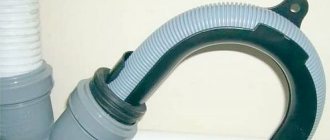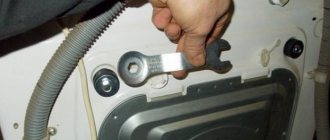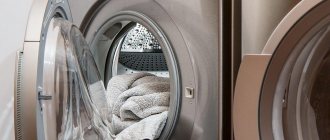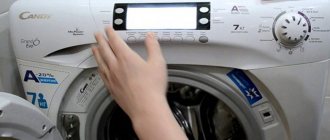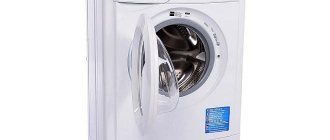If the washing program has completed, but the water has not completely drained from the drum or the clothes remain too wet, it means that the Atlant washing machine does not spin out the laundry. This situation occurs often, but large-scale breakdowns do not always lead to poor-quality spinning. Perhaps an imbalance or simple inattention is to blame. We suggest you figure out why the drum does not spin up to full power and how to solve this problem on your own. Let's look at all the typical problems and ways to fix them.
Where to look for a breakdown?
You can deal with wet laundry by taking it out of the drum and manually wringing it over the bathtub. But this will not only require a lot of effort and time, but will put the washing machine at risk. By turning a blind eye to suspicious “symptoms”, you can aggravate the problem up to the “death” of the equipment. It is better not to complicate your life, but to respond to the problem in a timely manner.
First of all, it’s worth figuring out what breakdowns and failures cause the spin to not work. On Atlant washing machines, the drum does not spin in the following situations:
- No spin mode is on;
- the drum is unbalanced;
- the drainage system is not functioning;
- the tachometer is broken;
- the electric motor does not accelerate;
- the bearing unit was damaged;
- the control board has failed;
- the drum is jammed due to a foreign object getting into the tank.
If the washing machine is under warranty, then it is prohibited to open the case yourself - all manipulations are carried out in a service center.
In 99% of cases, you can deal with a non-working spin on your own. You just need to consistently check all the designated “sore points” of the Atlant washing machine, not forgetting about safety precautions. Specific instructions on how and what to do are given below.
Checking the belt
This element is present in almost any modern washing machine, with the exception of direct drive SMAs, the founder of which is the Korean company LG.
SMA motor drive belt
Using a belt, rotational motion is transmitted from the motor to the drum. It is based on rubber. Over time, as well as with systematic overloads, the belt stretches. Moreover, in erase mode, it fully performs its function.
And when doing push-ups, it starts to slip due to lack of grip due to stretching. As a result, the drum does not rotate and the laundry does not spin out.
Expert opinion
I work in the household appliance repair industry. Extensive experience in restoring washing machines and dishwashers.
Ask a Question
There is only one way out in this situation - buying a new belt. Note that there are a wide variety of models, and you need to purchase the one that matches the product number of the washing machine.
It's fairly easy to remove. It is enough to pull it towards you while slightly rotating the shaft. Installed as follows:
- First we put it on the engine;
- then onto the drum pulley as far as it will fit;
- holding the belt with one hand and rotating with the other;
- Pull it all the way.
Are you unplugging your washing machine?
Oh yes! No
Most washing machines have a lid that can be removed from the back. This is enough to complete the replacement job. But in cars such as Zanussi, Electrolux and AEG, the rear housing must be removed. This is the specificity of these models.
Error in selecting mode
If the machine has not wrung out the laundry, then there is no need to panic. Often the problem is not a breakdown, but simple carelessness. For example, when the user accidentally selects a mode in which the spin is automatically set to a minimum of 400-600 rpm. Basic programs include “Down”, “Wool”, “Curtains”, “Delicate”, “Handmade” and “Silk”.
It’s easy to confirm or refute a guess: we remember which program was chosen and read its features in the instructions. Or we go the experimental way, starting a new cycle with a spin mode - “Spin”, “Children’s”, “Cotton” or “Fast”. If the laundry in the drum dries out, it means a mistake was made.
It is recommended to use the “Child Lock” option, which will prevent accidental changes to the cycle settings.
Don’t forget about the possibility of accidentally reducing the intensity of drum rotation. Many modern washing machines allow you to freely change factory settings, including canceling the spin cycle. It is enough to accidentally touch one of the panel buttons to change the speed from maximum to minimum. It is better to carry out a test wash, monitoring the displayed indicators. If things are not wrung out, then we proceed to diagnostics.
Pre-check
If the washing machine has been leveled and all transport bolts on the rear wall (drum side) have been removed, then you should check:
- how the water drain works and, if necessary, you should clean the hose or filter from clogging;
- whether the button that sets a reduced speed for a delicate spin has been accidentally pressed;
- whether the operating mode without spin is selected when washing woolen or silk laundry, in this case it is necessary to switch the mode to spin;
- Is the drum overloaded with laundry, because for this reason it will rotate more slowly and the laundry will not be spun well. The drum may even fail.
If the drum is underloaded with things, then they will not be distributed evenly around its circumference and vibration may occur at high drum speeds. The machine automatically reduces the speed, so the spin becomes insufficient. To prevent this, wash one large item with 2-4 small ones.
You should use powders, bleaches and fabric softeners recommended by the manufacturers, and do not allow them in excess - this can cause poor spinning. When washing and spinning, delicate items are placed in a special mesh.
Perhaps it's an imbalance
The most common cause of missing spin is imbalance. In simple words, when the drum spins, it gets knocked off its given axis and begins to hit the walls of the tank. For safety reasons, the machine stops rotating, the cycle ends 7-15 minutes earlier, and the clothes are not wrung out.
Failure to comply with drum loading standards leads to imbalance: overloading or underloading. Clumping of linen also disrupts the balance when, for example, it gets stuffed into a hole in a duvet cover and is distributed unevenly along the walls. Modern machines are able to detect suspicious swaying and display the corresponding error code on the display. Old models only stop the cycle, leaving users confused.
If you suspect an imbalance, you should:
- wait until the machine turns off the UBL;
- open the hatch and assess the situation (overload, underload or knockdown);
- eliminate the problem (by pulling out some of the laundry, adding items or breaking up the lump and distributing the clothes in the drum);
- close the door;
- activate spin;
- make sure the laundry is wrung out.
Failure to comply with loading standards leads to drum imbalance!
It is better to avoid imbalance and constantly monitor the number of items washed. Unbalancing destroys the bearing assembly, drum shaft and shock absorption system, not to mention possible internal mechanical damage. Be sure to remember both the upper and lower limits (both are indicated in the factory instructions). Thus, the Atlant washing machine with a capacity of up to 5 kg washes 1 kg of laundry at a time, and with a load of 8-9 kg the minimum is set to 2.5 kg.
Special cases: different models
If Samsung doesn't press
The Samsung washing machine does not spin for the above reasons and the following:
| What to do | |
| Works for a long time without stopping | Check the water level in the car, water pressure in the tap |
| There is no spin, the engine hums after draining the water | It is necessary to inspect the device by a service specialist |
| During the spin cycle, the drum stops, accompanied by dull knocks. | Set the machine level, unravel the laundry for better distribution throughout the drum |
| Poor laundry | Reduce the percentage of synthetic laundry when washing with natural items, or wash separately |
| No spin on every mode | Call a service engineer to repair internal components |
| No spin in winter | Check the water drain, whether there is rust or dirt in the hose, or whether the sewer is frozen |
| The heating element does not heat the water or increases the temperature of cold water | Repair the heating element or replace it with the help of a service department |
Selecting the boil and dry cycle will take longer to wash your laundry.
How to repair spin in LG
To find out the reasons for the lack of spin in LG washing machine models and eliminate them, you must:
- Remove the panel at the back of the machine and the cover on top of it. On the cover, unscrew 2 screws on each side and remove the bracket. The lid is moved back a few centimeters and lifted. The panel at the back of the unit is slightly bent to release it from the grooves.
Check the 3-phase motor for the integrity of its windings by turning on a multimeter and measuring Ohms. The motor connector with three pins must be disconnected. The resistance between the three wires (contacts) is normally 7.5-7.8 ohms.
Check the control module while simultaneously switching the unit to diagnostic mode by holding the “Spin speed” mode speed button and the “Soil level” button, then pressing the power button.
During diagnostics, press the “Start” button once to lock the door, and a second time to proceed to the spin cycle.
If there are zero readings (at zero revolutions) and the engine does not rotate, disconnect the connector from the engine at the rear of the machine.
A multimeter measures alternating voltage. Normally, it is between three contacts - 140-150 Volts. There is no voltage - the control module is faulty.
To replace the module, turn off the power from the unit and unscrew 1 screw from the pressure switch, remove it and put it aside. Next, remove the power connector and other connectors, carefully opening the latches with a knife and disconnecting them. All connectors on the front side must be disconnected, and the screw on the back side of the control module must be unscrewed. Now the module is shifted to the right and pulled out. In reverse order, then install the module in its place.
Why doesn't Indesit squeeze out?
The cause of spin malfunction in Indesit may be a malfunction of the “spin shutdown” switch, electronic module, or tachometer. When using the machine, the cause of poor spinning is simple inattention: turn on the “No spin” or “Delicate wash” mode, which does not involve spinning clothes or linen.
Again, the drum should be loaded according to the instructions, without exceeding or decreasing the required weight of the laundry, and also comply with all conditions for the normal operation of the machine. Severe breakdowns, such as a malfunction of the tachometer, water leaking into it and wear, malfunction of the engine or control module, are best left to a service specialist.
Discharge of waste water is not possible
It’s another matter if, after spinning, the water does not drain from the drum. Most likely, this is due to a non-functioning drain system - the washer cannot empty the tank due to a faulty pump, a blocked impeller or a blockage. To understand why the failure occurred and what to do, you will have to sequentially check all the identified problems.
- Eliminate sewer blockage. First, covering the hole with your hand, disconnect the drain hose from the sewer pipe and lower it into the bathtub or sink. The common drain may be clogged.
- We probe the hose. Next, carefully inspect the drain hose for blockages and kinks. If seals or foreign objects are noticed, the corrugation is disconnected and washed under the tap.
- Checking the filter. The garbage filter is located in the lower right corner of the machine behind the rectangular technical hatch. We pry up the last one with a screwdriver, remove it and, replacing the basin, unscrew the filter nozzle. All adhered dirt must be cleaned off.
- We look at the impeller and pump. The hole freed from the filter is illuminated with a flashlight. You need to find the snail, remove hair and lint from the blades, clean the pump body and “ring” all contacts with a multimeter.
The garbage filter is unscrewed strictly clockwise!
If the problem is a faulty pump or a damaged filter, then repair will not help - replacing broken parts is indicated. Once all the manipulations have been completed, you should assemble the machine and carry out a test wash. An empty drum after spinning will eliminate the fault of the drain system.
The tachometer should be tested
The washing machine will not be able to spin if the tachogenerator fails. Another name for the device is a Hall sensor, and it is responsible for the speed gained by the engine. If the device breaks down and stops recording speed, the control board loses connection with the motor and stops spinning for the safety of the equipment.
The following reasons can lead to problems with the tachometer:
- repeated drum overload;
- long-term operation of the machine without a “respite”;
- loose fixation of the device;
- detachment of contacts or damage to wires;
- sudden voltage surges or a short circuit that has occurred.
To diagnose the Hall sensor with your own hands, you need to remove the motor from the housing, find the tachogenerator attached to it and inspect it. Next, we tighten the terminals, strip the wires, test the connections with a multimeter and compare the results with the norm. If the device is faulty, then replacement is necessary.
Drive mechanism or speed sensor
If the cycle is configured correctly and imbalance is excluded, then we are talking about a breakdown. Probably, one of the units responsible for spinning the engine and drum has become unusable and requires diagnostics, repair or replacement. There are several possible “culprits”, so you will have to check each “suspect”, starting with the simple and ending with the complex.
The simplest thing is problems with the drive belt. The connection with the engine is obvious. It is the drive that ensures the transmission of revolutions from the accelerated motor to the drum shaft, which is necessary for rotating the drum during a full spin. If the rubber band flies off the pulley or breaks, then the engine runs “idle” and the machine itself remains motionless. The system detects a discrepancy, freezes or stops the cycle, dispensing wet laundry. Checking the condition of the drive belt is easy if you follow the following instructions:
- de-energize equipment;
- turn off the water;
- turn the equipment “backwards”;
- remove the back wall by unscrewing the screws around the perimeter;
- find the belt (the elastic band must be tensioned on the pulley wheel; if the tension is too weak or the rim has come off, then the “ring” needs to be changed).
To change the belt, you need to remove the old one and purchase a similar new one. Then we hook the rubber band onto the small wheel and try to pull it onto the large one, while simultaneously turning the pulley. Be prepared for the fact that you will have to put in a lot of effort and skill.
A intact and tensioned belt will clearly show that there are no problems with it. Then you should check the tachogenerator - a sensor in the form of a ring with wiring. It is installed on the engine and allows you to record the speed the engine is gaining. If the device fails, then control over engine acceleration is lost, the control board cannot monitor the rotation of the drum and, for safety reasons, it urgently shuts down the system.
Diagnostics of the tachometer proceeds as follows:
- Having turned off the power to the washing machine and unfolded it, unscrew the screws and remove the back wall;
- unhook the drive belt;
- we find the engine located under the tank;
- unscrew the bolts holding the motor;
- swing and remove the engine from its seat;
- carefully disconnect the sensor from the body;
- We start “ringing” the tachometer (we connect the multimeter probes and measure the resistance at the contacts).
A serviceable tachometer is returned to its place, and a burnt-out one is replaced with a new one. The device cannot be repaired, and its cost is low, in the range of 500-1200 rubles.
Engine problem
You can figure it out yourself in cases where the engine has failed. Commutator motors slow down when the brushes are worn out or there are problems with the winding. To diagnose, you need to remove the motor from the washer:
- disconnect equipment from the power supply and water supply;
- remove the back panel;
- remove the drive belt;
- unhook the wiring and retaining bolts;
- rock the engine and take it out.
Electric brushes are always replaced in pairs!
All that remains is to clean the engine and inspect it, trying to notice signs of overheating (burning smell, dark spots, charred insulation). Then we check the electric brushes: we open the “cases” and evaluate the length of the “coal”. If the tip is less than 0.7-1.5 cm, then replace it with new ones. Finally, we test the winding with a multimeter.
Checking the tachometer generator
The engine contains a tachometer generator, which generates electrical signals with which the electronic module controls the speed of rotation of the rotor.
Motor elements
If it breaks down, it delivers the necessary information, and as a result the engine does not gain the required speed.
Expert opinion
I work in the household appliance repair industry. Extensive experience in restoring washing machines and dishwashers.
Ask a Question
Note that such a malfunction is caused by moisture getting on it or the contacts, and the generator may jump out of its seat. In rare cases, contact breakdown occurs.
In most cases, the situation can be corrected by disassembling and repairing the damage. Otherwise, a new generator or engine is needed. If you are unsure of your own abilities, then it is better to entrust such work to a service center specialist.
Are you using citric acid?
Oh yes! No
There's something extra in the tank
Jamming of the drum by a foreign object also leads to poor-quality spinning. Keys or a coin left in your pocket fall into the tank, and then awkwardly “stand up” and prevent the tank from rotating. You must act immediately, otherwise the walls of the containers, the market price of which is comparable to a new machine, will be damaged.
Before disassembling the machine, it is worth confirming the “diagnosis”. You need to disconnect the equipment from the power supply, drain the water, open the hatch and spin the drum. If rotation is difficult, a creaking or crackling sound is heard, it means there is a foreign object inside.
We proceed like this:
- disconnect the machine from the sewer and water supply;
- move away from the wall;
- remove the back panel;
- we find the heating element;
- photograph the “chip” with wires;
- unhook the wiring;
- unscrew the holding bolts;
- remove the heating element to the side;
- shine a flashlight through the hole;
- We remove the stuck object by hand or with a metal hook.
We recommend not to stop there, but to take advantage of the situation and carry out an extraordinary cleaning of the heating element. Then we assemble the machine and check whether the drum spins freely. Then we run a test wash and monitor the spin quality. If things remain wet, we look for the problem further.
Possible causes of noise and troubleshooting
In addition to poor-quality spinning or its complete absence, equipment can signal a breakdown in another way, namely, by making unusual loud sounds - noise, humming, ringing, etc.
The following recommendations will help you figure out what the cause may be and how to eliminate it.
Problem #1 - shipping bolts not removed
After the selected equipment is delivered home, buyers, as a rule, save on the cost of installing the machine and deal with the procedure themselves.
Connecting the product to the water supply and sewer system is quite simple. But they forget to remove the mounting bolts that secure the drum during transportation.
If the transport bolts are not removed, then when you first start the washing machine it starts to make a loud noise.
After discovering this problem, you should unscrew the remaining bolts and check the operation of the equipment again.
Problem #2 - foreign objects in the drum
When placing items to be washed in the drum, it is imperative to check for various items in your pockets - keys, coins, receipts or receipts.
When they get into the drum or tank of the machine, you can hear a tapping sound.
Objects that fall into the machine can cause serious damage to it and damage some parts. Moreover, small elements often fall into the holes of the drum, after which they are difficult to get out
Also, items that are decorated with metal rivets, large zippers with fasteners, chains, etc. can make noise when washing. To prevent them from knocking on the drum, you should turn the items inside out and then just place them in the washing machine.
Problem #3 - wear of the bearings in the machine
The drum in the washing machine rotates thanks to bearings. If parts are damaged, the drum stops rotating correctly and makes uncharacteristic noise.
To check whether this is the cause, you need to rotate the empty drum from side to side. When bearings wear out and fail, they prevent free rotation and play is felt. During washing, the equipment makes a lot of noise and may vibrate.
Most often, damage to parts is caused by wear of the oil seal: streaks of rust may appear on the machine. They can be seen if you remove the back cover from the product body.
If the cause is correctly determined, the bearings should be replaced.
To do this you will need to perform the following list of actions:
- Disconnect the washing machine from the sewer, water supply, and turn off the power.
- Disassemble the rear and top panels according to the instructions.
- Remove the dispenser and control unit by unscrewing the screws.
- Loosen the clamp, remove the counterweight, heating element, pipes and other parts that prevent access to the engine.
- Remove the motor.
- Remove the drum tank.
- Unscrew the drum to remove the pulley and unscrew the shaft.
- Knock out the bearing using a special tool - a knockout.
- Replace the seals.
- Install the new bearing into the seat.
- Reassemble the equipment in reverse order.
It is better to coat the tank connection points with a sealant. For convenience and to remember the order of the procedure, all steps taken can be recorded using photos or videos.
Problem #4 - problems with drum mounting
A characteristic sign of a weakened pulley is the presence of a click when the drum rotates. The identified problem is resolved quickly enough. Disassembling the washing machine is performed in the same manner as when replacing bearings.
You can tighten the pulley using a specially selected wrench - you need to fix the loose fasteners. For greater reliability, the bolt should be treated with sealant
After completing the procedure, you will need to check whether the washing machine makes noise during the spin cycle. It is better to run a short wash program with twisting to make sure it works correctly.
Problem #5 - Tank counterweights are poorly secured
In order to hold the tank while washing, the machine is equipped with counterweights. If you hear a loud noise during operation, you should check whether the fastenings of this unit are loose.
The bolts may become loose as a result of using the machine for a long time, and a new product may have a manufacturing defect. In the latter case, the equipment is subject to warranty repair.
If the unit fails, you will need to remove the panels of the machine and unscrew all the parts that prevent free access to the counterweights. Next, you need to check their integrity and secure the fastenings more tightly.
Problem #6 - Incorrect installation
When installing a washing machine, users do not always pay attention to the quality of the floor surface and the presence of unevenness on it.
As a rule, tiles are quite slippery and the machine can move on the floor. To do this, you need to glue rubber tips to the legs if they are missing.
The equipment should be installed according to the instructions, using a level or glass of water. If the surface is uneven, you can place a flat surface made of wood or other dense material under the washing machine.
Stores also sell special rubber installation mats.
Problem #7 - high noise level of a specific model
Increased noise levels may not cause any damage. Some budget cars are very noisy.
When purchasing a product, you should definitely be interested in this characteristic. The indicator in the equipment passport is indicated in dB. Quieter models do not exceed 54 dB during washing and 65 dB during twisting.
Some models of machines with a direct drive type - inverter washing machines - have a low noise level.
If a problem with increased noise is detected, you must check the product specifications specified in the documentation.
Destruction of the bearing unit
If the washing machine does not spin, and additionally produces previously uncharacteristic noise, squeaking and rumble, then it is worth checking the bearing assembly. Probably, the seals have become leaky, lost their tightness, and the water that got onto the bearings washed out the lubricant. The situation is restored by replacing all damaged parts.
Repairing a bearing assembly is a labor-intensive task. You will have to purchase replacement parts suitable for the washing machine, and then disassemble the machine almost completely, removing the counterweights, heating element, shock absorbers and tank. Then it is necessary to knock out the stuck bearings without damaging the crosspiece and the drum shaft. Accordingly, you will need a lot of tools and consumables.
Before disassembling, you should study the factory instructions and electrical diagram of the Atlant washing machine.
Before you start repairing a bearing assembly, you should soberly assess your strengths and abilities. Without experience and practice, it is easy to aggravate the problem: damage the wires, pierce the tank or bend the shaft. However, you will have to pay a large sum for the services of a specialist, since on average replacing bearings is estimated at a third of the cost of a new washing machine.
Prevention
In order for the washing machine to function for a long time without any problems, it is advisable to follow the operating rules for such equipment. To avoid problems with spinning, it is necessary to periodically check the filter, do not wash items with any mechanical inclusions in the pockets, maintain balancing, and also monitor the condition of the electrical circuits of the device.
Not spinning your washing machine can be a really annoying problem. However, correct identification of the cause will ensure prompt repair of the equipment yourself without turning to specialists.
Something with electronics
It’s worse if spinning is impossible due to problems with the electronics. The triac responsible for the motor burns out, so the motor loses connection with the board and does not spin the drum to the required speed. The machine either spins weakly or does not start at all.
The difficulty is that it is strongly not recommended to diagnose the board yourself. Without practice and special equipment, you can aggravate the problem to an irreversible state with one wrong move. It’s better not to experiment and entrust the module to professionals. Reflashing services are priced at several times lower than the cost of a new electronic unit.
Interesting:
- Reviews of Atlant washing machines
- The Atlant washing machine jumps
- Vestel washing machine does not spin clothes
- How to place a washing machine in the bathroom
- Beko washing machine does not spin
- The washing machine does not spin well - what should I do?
Reader comments
- Share your opinion - leave a comment
The washing machine does not open the door
If the water level sensor malfunctions, the system does not receive a signal to start draining water. Therefore, the machine does not press or open. In order to open the door and remove the laundry, you need to drain the water through the filter. Then wait until the lock is unlocked and open the door.
How to check the pressure switch (level sensor)? In all SM models “Ariston Hotpoint”, “Electrolux”, “Siemens”, “Daewoo”, “Atlant” the device is located under the top cover.
- Remove the two screws from the back.
- Move the cover away from you and remove it from the body.
- You will notice a pressure switch near the wall.
- Disconnect its tubes and check for blockages.
- The device itself is checked with a multimeter. Its probes are applied to the contacts of the device, and the indicators are measured.
If the sensor is faulty, install a new device.



